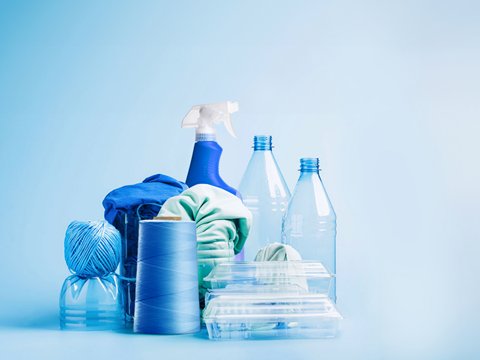
A new study has been published by Systemiq outlining a roadmap to transition the U.S. PET packaging and polyester textile industries from the current linear single-use model towards circular, low-waste and low-emission systems by 2040.
Titled ‘Transforming PET Packaging and Textiles in the United States’, the study’s launch follows landmark policy announcements including the recent passage of the Responsible Textile Recovery Act of 2024 in California and the Executive Order on Mobilizing Federal Action on Plastic Pollution. Extended Producer Responsibility (EPR) laws for packaging have been passed in five states (California, Colorado, Maine, Minnesota, Oregon) and are being considered in ten others.
PET packaging and polyester textiles – used in items like beverage bottles, food trays, apparel and carpets – are made from the same molecule. Systemiq says U.S. consumers currently use over 100 billion PET bottles and over 10 billion polyester garments each year. Apparently, these materials constitute 30% of the U.S. plastic packaging and textile consumption.
If current trends continue, PET and polyester consumption is predicted to grow 1.5 times by 2040, resulting in 13 million metric tons of waste sent to landfill and incineration annually. Greenhouse gas (GHG) emissions from domestic PET and polyester production would be 2.5 times higher by 2040 than the levels needed to meet U.S. emissions reduction targets.
The study - undertaken with support from Closed Loop Partners, Eunomia and The Recycling Partnership - emphasizes the potential of circular economy approaches such as reducing avoidable material use, scaling packaging reuse and textiles resale, and expanding recycling through both mechanical and depolymerization technologies.
It states that by 2040, applying these measures - compared to a continuation of historical trends - could result in environmental benefits including increased recycling rates for PET packaging from 23% to 70% and from 1% to 19% for polyester textiles; halved virgin PET/polyester consumption and waste sent to landfill and incineration; and a 60% cut in projected GHG emissions for packaging.
The report calls for action from U.S. policymakers, such as implementing well-designed EPR laws, incentivizing U.S. domestic infrastructure, expanding collection and sortation capabilities and setting mandates to boost demand for post-consumer recycled PET (rPET). It calls on industry leaders to reduce unnecessary consumption of packaging and textiles, design products for reuse and recycling, scale textiles collection, and increase the use of domestically sourced rPET.
The study also highlights the need for collaboration between government, industry and investors to create the enabling environment, investment flows and industry adoption required to deploy new and proven technologies - artificial intelligence-based waste sortation and depolymerization recycling, for example - at scale.
In March, a report by Plastics Recyclers Europe said that the average EU PET beverage bottles’ recycled content rate had reached 24%, but that disparities between EU Member States need addressing to achieve 2025 EU targets. It reported that PET collection and recycling accelerated in 2022 ahead of the new EU Single-Use Plastic Directive (SUPD) targets, with the collection rate of PET in 2022 calculated at 60%, an increase from the 45% achieved in 2020.
The following month, EA Earth Action, SAP, Systemiq, and Delterra came together to introduce Packaging IQ 2.0 – an update to a data-driven platform designed to help companies measure and cut down on the impact of their plastic waste, in line with the upcoming Global Plastics Treaty. Packaging IQ 2.0 aspires to provide brands and retailers with the relevant economic, policy, and environmental insights for particular packaging formats and markets.
If you liked this story, you might also enjoy:
The ultimate guide to the Packaging and Packaging Waste Regulation in 2024
How are the top brands progressing on packaging sustainability?
Sustainable Innovation Report 2024: Current trends and future priorities
Everything you need to know about global plastic sustainability regulation











No comments yet